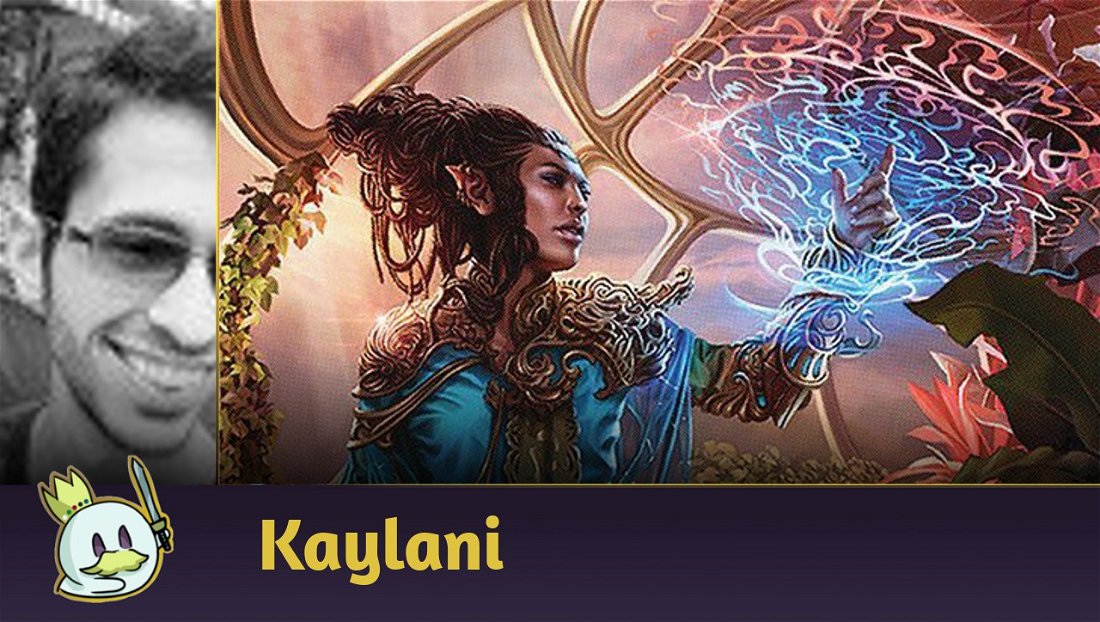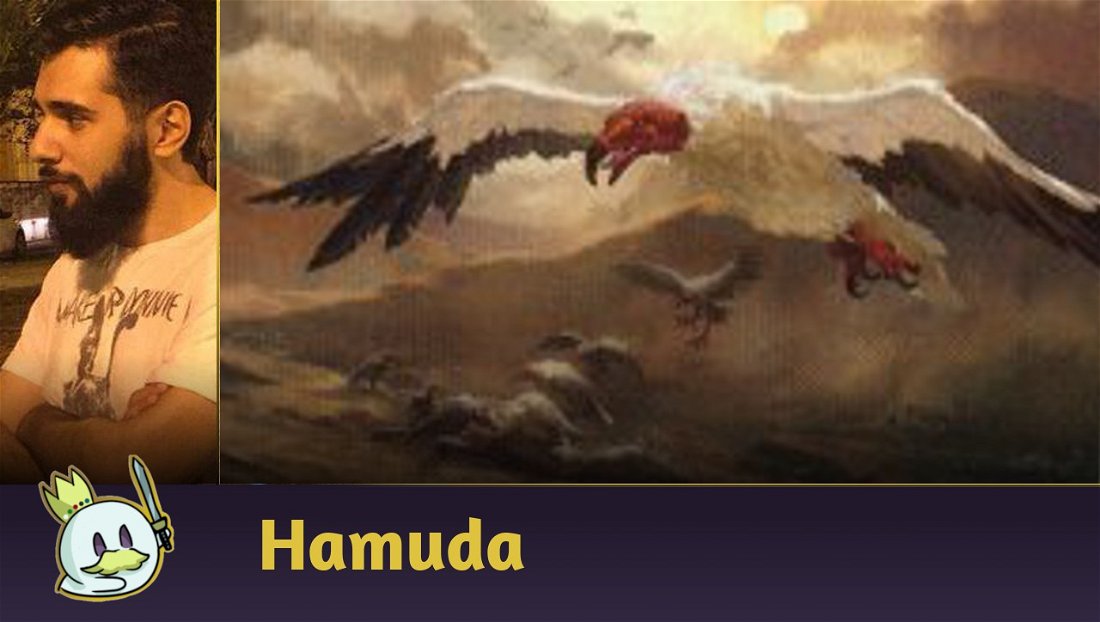If you have a barrel of good quality and nice wood, like mahogany, for example, it's easy to go down Niagara Falls with it. Woody Woodpecker was already doing this in my favorite cartoon episode, as were many people before him. Nowadays this practice is prohibited, but luckily for us, Magic offers an equally valid option of hitchhiking in a hydrographic formation.
In today's article we will explore a game strategy that at first glance seems chaotic and makes players who have not yet fully understood it think that it is a totally random and uncontrolled experience, but that, in fact, it is a very exact science. We are talking about Cascade, and the new commander that the game gave us, Imoti, Celebrant of Bounty.

As, unfortunately, A Tribal Commander based on Nagas and Druids are not yet a viable game strategy, we can go straight to the point with Imoti. Like the Sun, which our Earth revolves around, the Cascade skill is the central point at which the deck will revolve around.
Imoti, by itself, already has the cascade ability in its text, that is, an ability that allows you to reveal cards from the top of your deck until you find a converted mana cost card lower than the one with the cascade ability, and that is not a land, and then allows this found card to be cast without paying its cost. The remaining cards are shuffled randomly and placed at the bottom of the deck.
Imoti already has a mana cost of five, which allows you to cast several cards costing four or less for free. But why she calls attention as a commander is her second ability. Thanks to it, spells with a converted mana cost of 6 or more also gain a cascade. That means a Nezahal, Primal Tide cost 7 will cascade a spell with converted mana cost 6 or less.

If that weren't enough, Cascade is a cumulative ability and creatures can have multiple instances of it allowing them to activate individually, unlike Double Strike, for example, that having two instances of that ability won't make the creature hit four times. So, if you have your Imoti in the field and cast a Maelstrom Colossus, which has a mana cost of 8 and "Cascade", it changes to "Cascade, Cascade" and activates twice in a row, allowing you to cast two spells costing 7 or less.
Completing this Imoti ability even further, we fall into a technical implication that improves it dramatically, but for that we will have to deeply understand both the keyword Cascade and the second ability of this creature.
As stated, this ability is activated when you cast a spell, using a Show and Tell to a creature with the ability will not activate it, since this card causes the creature to be placed on the field, not cast . Continuing in the text of the skill, we also see that the spells revealed by mechanics are taken into exile first, from where they are then cast, even if at zero cost and outside the player's hand.

"Conjured" is a word that is being mentioned repeatedly here because of Imoti's second ability, which is activated by casting, and once spells revealed with her are cast, it will create a series of activations of the ability. Then, with Imoti on the field, by conjuring a Pathrazer of Ulamog he may end up revealing a Ulamog, the Ceaseless Hunger, which will be conjured with an instance of Cascade in his effect, which he may reveal a Dig Through Time, which will also have the ability added to your text, and so on, until you reach a mana cost card below 6. Also remember that, as already mentioned, any card that already have Cascade will gain one more trigger, thus proliferating spells in an exaggerated manner and yielding several “Oh Crap” with each new activation of the ability.
Before we talk about the decks we can set up with Imoti, let's just solve one last question about the Cascade ability that will happen constantly with first-timers piloting the deck. For that, I affirm that; the only thing that changes the converted mana cost of a card in the stack is when the spell has an X in its cost. Thus, even if a Stonecoil Serpent has a converted cost of 0 in the hand, in the field and everywhere, in the stack its mana cost is equal to the amount of mana spent on it. Assuming that seven mana have been spent, not only is the cost of Stonecoil 7 in the stack, but you will also activate Cascade if Imoti is on the field.
In all other situations, unless a card says otherwise, the converted mana cost of the cards will be the one printed on them. Assuming you lost Imoti once in the game and will play it from the command zone costing two more, even if you spent seven mana, its converted mana cost is still 5, making it search only for cmc 4 or less cards.
This is also true for reverse situations. If you have a card that lowers costs, such as a Arcane Melee that lowers the mana cost of instant and sorceries by two, and then cast a Overflowing Insight, even if you only paid five mana for it, the card still has a converted cost of 7, allowing it to become eligible for Imoti's Cascade ability, which will occur normally.
So we must always remember, that unless the card has X in its mana cost, its cost in the pile does not change due to the amount of mana paid to conjure it. Ignoring this rule will not only cause a sub-optimal way to set up and pilot the deck, it can also cause a disagreement between players and even the perpetuation of bad habits in a group.
Now let's go to the main part of building your expensive cardboard Ferrari, the parts that will compose it.
Like every legendary creature we have a dilemma, use Imoti as a commander or as one of her ninety-nine cards? Unfortunately, in that case we don't have such a simple solution. Obviously, because it is an article focused on the card, it is all articulated in the idea that we will use it as commander, but it is good to point out what you gain by abdicating it in the main post to include it in the normal way in the deck. The main answer is a wider range of colors. Imoti is the Cascade commander with the smallest identity ever launched so far, while the only other, Yidris, Maelstrom Wielder, has twice as many colors available. With access to red and black, in addition to blue and green, a Yidris deck gets access to more tools to deal with opponents. A great example is the direct removal of creatures. However, the qualities provided by Imoti's color identity are already extremely important in the commander. With it we have ramp, artifact and enchantment removal, and the powerful creatures of the green, as well as the board and deck control brought by the blue. Of course, both colors have the best draw qualities in the game.

It does not necessarily have to be used on a Cascade deck, either. Big Mana decks, which by chance happen to use blue and green, or even Temur spelsslinger decks would benefit a lot. My example here is the Kalamax, the Stormsire, which with Imoti on the field would copy the firstl of its spells with Cascade.
Whether with Cascade decks or not, using Imoti as one of the ninety-nine cards on the deck is just like that 90's anime magazine with a Gohan poster, you may not be looking for it, but as soon as you find it, you'll feel like it to put it in the field for everyone to see. Her simple presence on the table is able to speed up horrors on any deck that uses it, being a good addition to any deck in colors that deal with large cards and have nothing to add.
Contrary to what many people imagine, Cascade is not a sub-archetype of chaos decks. If you are piloting your Kalamax Temur deck and cascading something with it, you will only have access to cards that apply the following conditions; are not land, have converted mana cost lower than the cascade card and, most importantly, are in your deck.
If you cascade with an Imoti that was between ninety-nine you can very easily find a Vow of Flight. You put it on your deck and you know that its cost allows it to be fetched by the creature's cascade. It was a premeditated option among the various probabilities offered. There is no way for you to do that and find a copy of Lurking Witch that you were branding pages in your copy of Harry Potter and the Order of the Phoenix and remained inside when you loaned it to your cousin.
Thus, the deck of Imoti must be made with the greatest care in order to better use this ability. Premeditating each curve in order to make long cascades. Cards must also be chosen to be useful throughout the game, in as many steps as possible, for the Cascade to work.
A Heroic Intervention, for example, is a great situational card, but often when revealed in the cascade, it will be a misuse of the ability and the card will be thrown to the bottom of the deck without being cast.
A Sakura-Tribe Elder, for example, has the same converted cost, but it helps in the beginning and middle of the game by ramping, and even if it is the result of a cascade towards late-game, you can still use it to block and ramp a bit, in addition to filtering the deck and slightly improving your draws at the end of the game.

Another great idea is the Thunderous Snapper, which gives you card draw by conjuring cards costing five or more, which perfectly applies to the commander and the cards it gives the cascade ability to, so, you doubling your card advantage for each spell cast.
And if you want to make all of this even more favorable for your side, Gilanra, Caller of Wirewood, is an elf that not only generates mana, but that draws you when that mana is used to conjure a spell with cmc 6 or greater. Making expensive cards yield a cascade and two extra draws when these three are on the table, but still, doing wonders when either one of these pieces is alone.

Another great idea for this deck is the use of cards like Dig Trough Time, Primeval Protector and Ghalta, Primal Hunger that can be conjured at a lower cost under certain conditions , but that still go to the pile with its full cost, improving the cascade. As well as cards that already have a cascade instance, such as Maelstrom Colossus, and of course, Apex Devastator, which with Imoti in the field, will cascade five times, with a chance of each one of these activations generates more cascades trigger.
With these primary ideas, the deck looks more or less like this, based on a list of Big Mana that I found on user Asheler's EDHRec and that I changed a few things, giving a focus on the synergy of higher cost cards and also, that I cheapened a little bit of his monetary cost;
One of my favorite choices for this build is Thryx, the Sudden Storm. This card may not meet Imoti's requirements to generate a card advantage, but it alone gives a good quality to the deck. In addition to being easily found by cascading, and having Flash, allowing it to protect itself from removal at sorcery speed and discards at the same time, it also creates protection against counterspells for your biggest spells, bringing more security to your game.
To bring even more security, we have Brinelin, the Moon Kraken, which, like the aforementioned cards that draw for spells of cost 6 or higher, it returns a nonland permanent to the owner's hand, the which can create disruption in the opponent's field or return cards that have been stolen.
This is not a tech deck, but see, when a Big Mana is built around the idea of “when a spell of cost X or greater is cast, Y happens” and support this type of card, such as Fierce Empath, which lets you tutor a card of six or higher right into your hand, or with the aforementioned Thryx, which protects these cards from being countered, when combined with a ramp to which many deck spells contribute, such as Beanstalk Giant that works as a ramp AND a creature capable of cascading later, it is possible to create a very stable and strong build for Imoti, Celebrant of Generosity, mainly added with the support for blue and green that the game has been receiving lately.
A Cascade deck starring Imoti, as shown here, has nothing to lose compared to any other deck by the commander. The closer to the end of the game, this card that was supposed to be an unusual one, shows more and more value and becomes more and more a threat to the state of the game, thus showing itself, an idea that deserves to be studied and perfected .
Now, if you excuse me, I have my favorite TV show about Armadillos coming up and I can't miss it !














— Comments 0
, Reactions 1
Be the first to comment